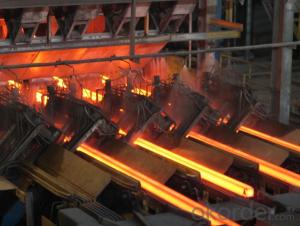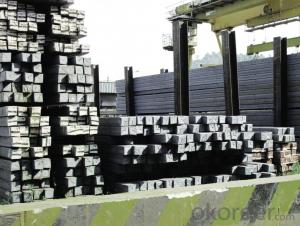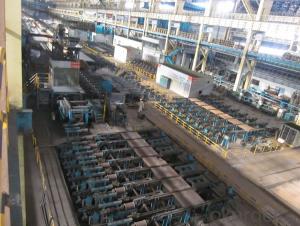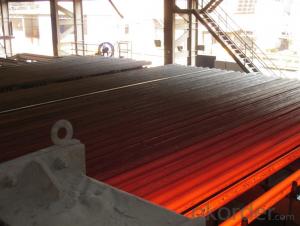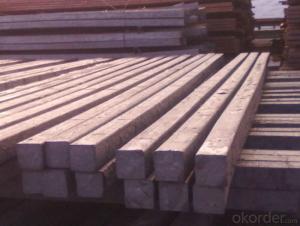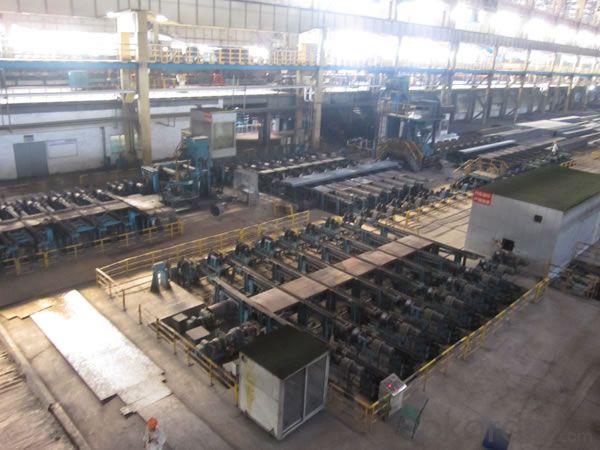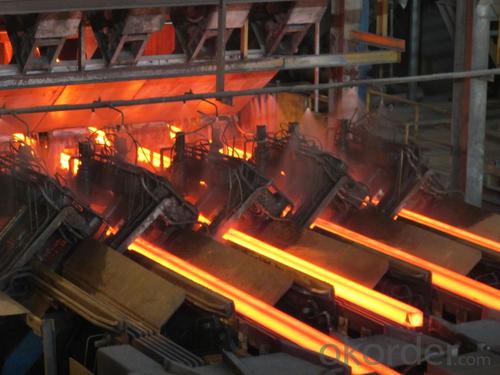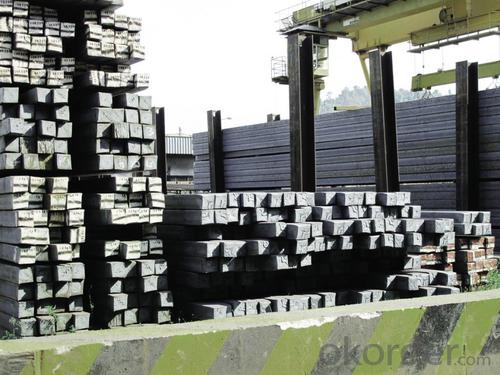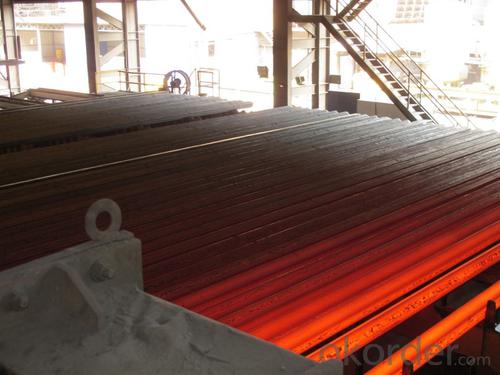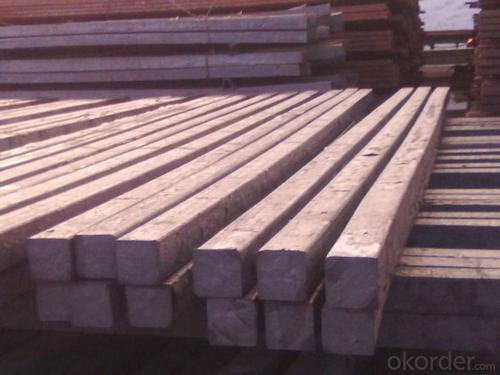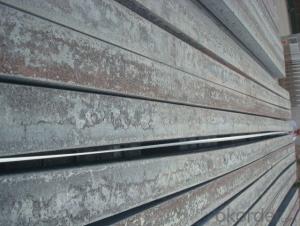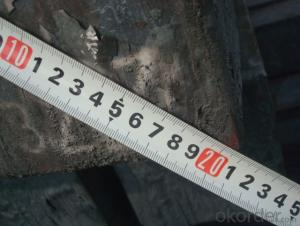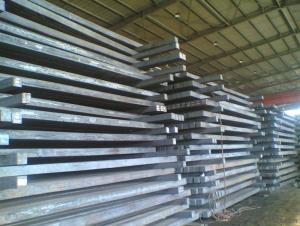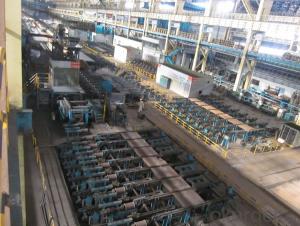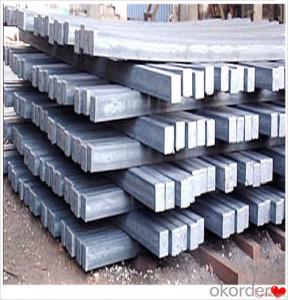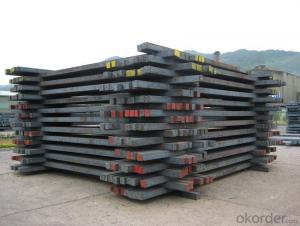Prime Q275 90mm Square Alloy Steel Billet
- Loading Port:
- Shanghai
- Payment Terms:
- TT OR LC
- Min Order Qty:
- 100 m.t.
- Supply Capability:
- 10000 m.t./month
OKorder Service Pledge
OKorder Financial Service
You Might Also Like
Structure of Prime Q275 90mm Square Alloy Steel Billet

Description of Prime Q275 90mm Square Alloy Steel Billet
1. Prepainted steel coil is coated with organic layer, which provides higher anti-corrosion property and a longer lifespan than that of galvanized or galvalume steel sheets.
2. The base metals for prepainted steel coil consist of cold rolled, HDGI Steel, electro-galvanized and hot-dip alu-zinc coated steel. The finish coats of prepainted steel coil can be classified into groups as follows: polyester, silicon modified polyesters, polyvinylidene fluoride, high-durability polyester, etc.
3. The production process has evolved from one-coating-and-one-baking to double-coating-and-double-baking, and even three-coating-and-three-baking.
4. The color of the prepainted steel coil has a very wide selection, like orange, cream-colored, dark sky blue, sea blue, bright red, brick red, ivory white, porcelain blue, etc.
5. The prepainted steel coils can also be classified into groups by their surface textures, namely regular prepainted sheets, embossed sheets and printed sheets.

Main Feature of Prime Q275 90mm Square Alloy Steel Billet
Uncoated CR steel sheet
With the features of in line with the international highest standards in demension and shape, excellent surface finish and properties, the products are mainly used in home appliance and automobile industries.
Galvanized steel sheet(include HDG and EG)
With the features of good corrosion resistance, the products are mainly used in automobile, home appliance, electronics, building and machinery manufacture industries, etc.
Precoated steel sheet
With the features of enviromental protection and good processablility, long lasting surface durability, rich in colors, the products are maily used in building, home appliance and furniture industries, etc.
Applications of Prime Q275 90mm Square Alloy Steel Billet
A. Corrugated design makes it excellent waterproof performance
B. Materials as prepainted steel sheets, galvanized steel sheets, galvalume (Al-Zn coated sheets) are available to make corrugated sheet.
C.Those material are durable, anti-corrosion in bad weather for 20-30 years based on it's Zinc(Galvanized) coating or AZ (Galvalume) coating.
D. Different shape of the sheet make it suitable for any style of buildings.
E.Easy to install, no need special tools to fix the sheet.
F.Light weight due to high strength to weight ratio of steel. Light weight means easier handling lower shipping costs, easier installation
G. Different color is availbe base on the RAL Standard make your building more beautiful.
H. We will provide the best solutions if you don't have a exact idea of the specification you want for the steel sheet based on your weather conditions, engineering structure, construction budget and so on.

Specifications of Prime Q275 90mm Square Alloy Steel Billet
Product | Billet |
Material Grade | SGCC / SGCH / DX51D+AZ, etc |
Thickness | 0.6-3.0mm |
Width | 500-1500mm |
Tolerance | Thickness: +/-0.02mm , Width:+/-2mm |
Zinc-coating | Z30-150g/m2 |
Technique | Raw material: Hot rolled steel coil --> Cold rolled_>hot dipped galvalume |
Surface | Dried, Chromated, Unoiled |
Spangle | Regular spangle , small spangle, zero spangle |
ID | 508MM 610MM |
Coil weight | 1-25MT |
Export package | Cardboard inner sleeves, Waterproof paper, galvanized steel covered and steel strip packed |
FAQ of Prime Q275 90mm Square Alloy Steel Billet
We have organized several common questions for our clients,may help you sincerely:
1. How Can I Visit There?
Our company is located in Tianjin City, China, near Beijing. You can fly to Tianjin Airport Directly. All our clients, from home or aboard, are warmly welcome to visit us!
2. How Can I Get Some Sample?
We are honored to offer you sample.
3. Why choose CNBM?
Our delivery time about 15-20days for standard sizes, if you have other requirements like hardness, quanity and width ,it is about 20-40days. But don't worry we also try our best for the delivery time ,because time longer and our cost is higher.
- Q: What is the difference between steel billets and steel ingots?
- Steel billets and steel ingots are both semi-finished steel products, but they differ in terms of their shape and manufacturing process. Steel billets are rectangular or square-shaped bars that are typically produced through a continuous casting process. This involves pouring molten steel into molds and allowing it to solidify into the desired shape. Billets are usually used as raw material for further processing, such as rolling or forging, to produce finished steel products like bars, rods, or wire. On the other hand, steel ingots are large, solid blocks of steel that are typically produced through a traditional casting process. In this process, molten steel is poured into large molds and allowed to cool and solidify. Ingots are usually used for the production of larger steel components or as feedstock for forging or rolling operations. They are often remelted and refined before being processed into the final product. In terms of size, billets are generally smaller and have a cross-sectional area ranging from 36 to 155 square inches. Ingots, on the other hand, are larger and have a cross-sectional area exceeding 155 square inches. Both steel billets and steel ingots serve as intermediary products in the steel manufacturing industry. The choice between using billets or ingots depends on the specific requirements of the final steel product and the manufacturing process involved.
- Q: What is the cost of a steel billet?
- The cost of a steel billet can change based on several factors including size, grade, and market conditions. Steel billets are semi-finished products used as raw materials for various steel products. The price of a steel billet is typically given per metric ton. To determine the cost, one needs to consider the current market price of steel, which can fluctuate due to factors such as supply and demand, international trade policies, and global economic conditions. Furthermore, the grade of the steel billet can impact the cost since different grades have different levels of purity and specifications. It is crucial to contact steel suppliers or refer to market reports for accurate and current information on the cost of steel billets. Additionally, additional factors like transportation and handling costs may also affect the final price.
- Q: How do steel billets compare to other metal billets?
- Steel billets are generally considered superior to other metal billets due to their high strength, durability, and versatility. Steel billets offer excellent weldability, machinability, and resistance to corrosion, making them suitable for a wide range of applications in industries such as construction, automotive, and manufacturing. Additionally, steel billets can be easily modified and shaped into various forms, allowing for efficient and precise fabrication processes.
- Q: How do steel billets contribute to the manufacturing of rail and transportation systems?
- Steel billets are an essential component in the manufacturing of rail and transportation systems. These billets serve as the raw material for the production of various components used in the construction of railways, such as rails, sleepers, and fasteners. One of the primary uses of steel billets in rail manufacturing is for the production of railway tracks. Steel billets are first heated and then rolled into long, slender sections called rails. These rails are then further processed and treated to withstand the heavy loads and constant wear and tear experienced in railway operations. The durability, strength, and resistance to deformation of steel make it an ideal material for railway tracks, ensuring safe and efficient transportation. Steel billets also play a vital role in the manufacturing of sleepers or railroad ties, which are used to support the rails and maintain their alignment. These sleepers, typically made from prestressed concrete or wood, require reinforcing bars made from steel billets to enhance their strength and structural integrity. Additionally, steel billets are used to produce fasteners, such as bolts, clips, and spikes, which are crucial for securely fastening rails to sleepers and maintaining track stability. Moreover, steel billets are used in the production of various transportation system components, including chassis, frames, and suspension systems for trains, trams, buses, and other vehicles. Their high strength and excellent formability make steel billets an ideal choice for these applications, as they can withstand the heavy loads and provide structural integrity necessary for safe and reliable transportation. In summary, steel billets play a significant role in the manufacturing of rail and transportation systems. From the production of railway tracks to the fabrication of sleepers, fasteners, and vehicle components, steel billets provide the necessary strength, durability, and structural integrity required for the efficient and safe operation of railways and transportation systems.
- Q: What are the different types of steel billets used in the manufacturing industry?
- There are several different types of steel billets used in the manufacturing industry, each with its own unique properties and qualities. Some of the most common types include: 1. Carbon Steel Billets: These are the most widely used type of steel billets and are made primarily from iron and carbon. They are known for their high strength and durability and are used in a variety of applications, including construction, automotive, and machinery manufacturing. 2. Alloy Steel Billets: Alloy steel billets are made by adding various alloying elements to carbon steel, such as manganese, nickel, chromium, and molybdenum. This results in improved properties such as increased strength, hardness, and resistance to corrosion. They are often used in the production of high-strength components and machinery parts. 3. Stainless Steel Billets: Stainless steel billets are made from iron, chromium, and other alloying elements, such as nickel and molybdenum. They are highly resistant to corrosion and staining and are commonly used in the manufacturing of kitchen appliances, automotive parts, and medical equipment. 4. Tool Steel Billets: Tool steel billets are specifically designed for use in the production of tools, dies, and molds. They have high hardness, wear resistance, and toughness, making them ideal for applications that require cutting, shaping, or molding materials. 5. Micro-Alloyed Steel Billets: These billets contain small amounts of alloying elements, such as vanadium, niobium, or titanium. They are used to improve the strength and toughness of the steel, making them suitable for structural applications in industries such as construction and transportation. It's important to note that these are just a few examples of the different types of steel billets used in the manufacturing industry. There are many other specialized types available, each tailored to meet specific requirements for different applications and industries.
- Q: How are steel billets stored?
- Steel billets are typically stored in open yards or covered warehouses, stacked neatly on top of each other in rows or piles. They are often placed on wooden or steel skids to protect them from moisture and to facilitate easy movement using forklifts or cranes. Additionally, billets are commonly stored in a way that allows proper ventilation and accessibility for inspection and transportation purposes.
- Q: What is the typical impact strength of a steel billet?
- The impact strength of a steel billet typically varies based on the grade and composition of the steel. Generally, steel billets have a high level of toughness and can endure significant impact forces without fracturing or breaking. This is because steel possesses inherent strength and ductility. Nevertheless, it is important to acknowledge that the impact strength of a steel billet can be further improved through various methods like heat treatment or alloying. These techniques assist in enhancing the material's resistance to impact, making it more durable and suitable for demanding applications. Essentially, to determine the exact impact strength of a steel billet, it is crucial to consider the specific grade and composition. Different steel grades are designed for different purposes, and consequently, their impact strength can vary. Therefore, it is advisable to consult the manufacturer or refer to the material specifications to obtain accurate and detailed information regarding the typical impact strength of a particular steel billet.
- Q: How are steel billets used in the manufacturing of mining equipment?
- Steel billets are used in the manufacturing of mining equipment as they serve as the starting material for various components. These billets are first heated and then shaped into desired forms such as gears, shafts, or frames, which are crucial for the construction of heavy-duty mining machinery. The strength and durability of steel make it an ideal choice for withstanding the harsh conditions and rigorous demands of mining operations.
- Q: How are steel billets used in the production of wire rods and bars?
- Steel billets are used in the production of wire rods and bars as they serve as the initial raw material. These billets are heated and then rolled or forged into long, slender shapes to create wire rods or bars. The size and shape of the billets determine the final dimensions of the wire rods or bars, which are used in various industries such as construction, automotive, and manufacturing.
- Q: What is the role of steel billets in the manufacturing of material handling equipment?
- Steel billets play a crucial role in the manufacturing of material handling equipment as they serve as the primary raw material for forging and shaping various components. These billets are heated, molded, and transformed into different parts such as frames, beams, brackets, and supports, which provide strength, durability, and stability to the equipment. Additionally, steel billets ensure the structural integrity and load-bearing capacity of the material handling equipment, enabling them to withstand heavy loads and rigorous operational conditions.
Send your message to us
Prime Q275 90mm Square Alloy Steel Billet
- Loading Port:
- Shanghai
- Payment Terms:
- TT OR LC
- Min Order Qty:
- 100 m.t.
- Supply Capability:
- 10000 m.t./month
OKorder Service Pledge
OKorder Financial Service
Similar products
Hot products
Hot Searches
Related keywords

